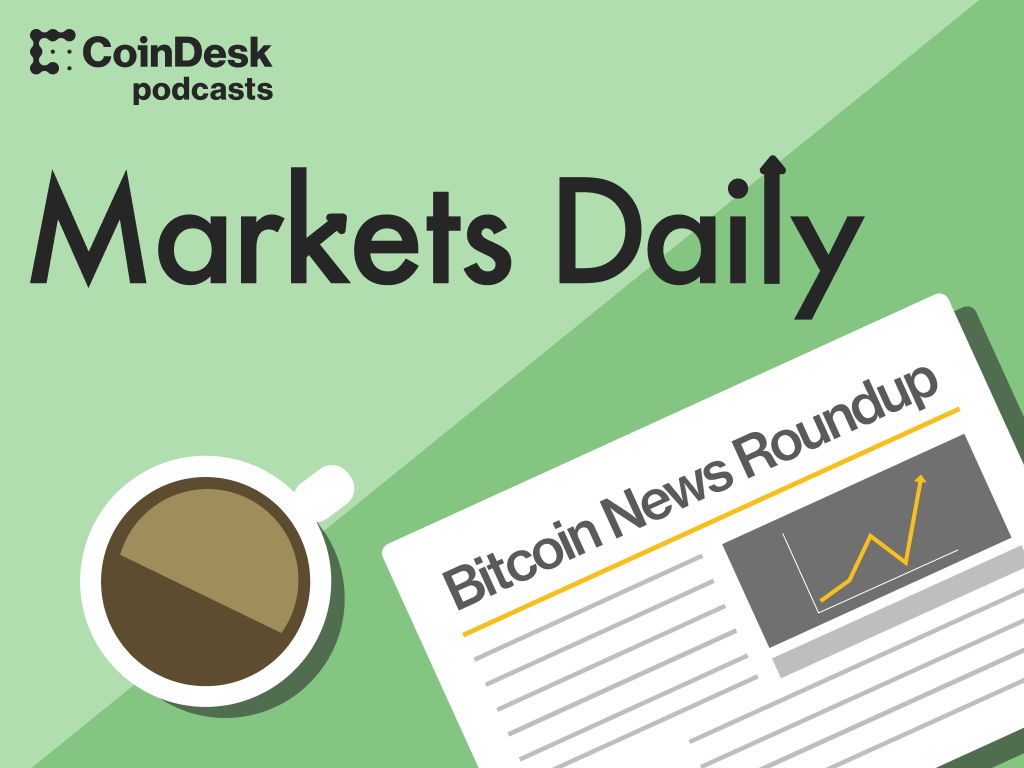To get the show every day, follow the podcast here.
Today on “Markets Daily,” host Jennifer Sanasie speaks with Kevin O’Leary, O’Leary Ventures chairman, about why he thinks spot bitcoin ETFs are “practically useless” for institutional investors. But, he does see the approvals as a milestone for other reasons – tune in to hear O’Leary’s full take on how the digital asset industry will evolve with the inclusion of U.S. spot bitcoin ETFs.
This episode was hosted by Jennifer Sanasie. “Markets Daily” is executive produced by Jared Schwartz and produced and edited by Eleanor Pahl, alongside Senior Booking Producer Melissa Montañez. All original music by Doc Blust and Colin Mealey.
Audio Transcript: This transcript has not been edited and may contain errors.
JENNIFER SANASIE:
It’s Thursday, January 11th, 2024 and this is “Markets Daily” from CoinDesk. I’m your host Jenn Sanasie and let’s dive into those prices. The moment traders have been waiting for has finally arrived: the U.S. Securities and Exchange Commision approved spot bitcoin ETFs yesterday, a landmark decision that could dramatically broaden the investor base for bitcoin. According to CoinDesk Indices, at 8 a.m. Eastern time, bitcoin was trading up 6% over the past 24 hours at $47,428. Ether is up a blistering 12% over the same time period, trading at $2,648. The spot bitcoin ETFs approval sparked optimism among ether traders, who are hoping for a spot ether product as well. Ethereum layer 2 tokens are rallying on the same optimism, with traders hoping to see a boost in the overall ecosystem. Today’s ‘Mover’ in the CoinDesk Market Index is Ethereum Name Service, ticker ENS, UP a massive 60% on the day. In traditional markets, U.S. stocks closed higher yesterday with the NASDAQ up 0.75% and S&P 500 UP 0.57%. And in commodities, the Brent crude benchmark is trading at 78 dollars and 19 cents a barrel. For more on the markets action, let’s bring in O’Leary Ventures Chairman, Kevin O’Leary. I gotta get your reaction right off the top: bitcoin up 6%, but ether is rallying even more as people anticipate a spot ether ETF. How are you feeling this morning? How are you looking at prices?
KEVIN O’LEARY:
Well, this will obviously broaden the base. But I think for investors, we’re all starting to think about what’s next because a spot eth ETF would be great. But it’s more than that. The question becomes now, and this is the million dollar billion dollar question, whatever you want to call it, will this trigger the adoption of allocation for sovereign wealth and pension? In other words, the reason if you were the Norway pension fund that you didn’t hold any bitcoin was that the SEC had not allowed it to become an institutional product. You know, people have been debating this for 10 years. But now that you have a spot price, and you can buy this thing in the form of an equity and an ETF in almost 13 different ways, does that allow you as the Norway pension, or the Abu Dhabi or the Dubai fund that has never held it, to put on a half a percent or one or one and a half percent weighting, which would be a tremendous boom, to what the price appreciation could look like over the next two years. And my guess is, yes, that’s going to happen. It’s going to happen slowly, not overnight. But then the question becomes, where are they going to hold it? Because I would never buy an ETF for bitcoin, why would I pay 21 basis points of fees? That’s pointless. But if it’s adopted by the regulator, that lets me go to an exchange to buy it. And I could hold it as a 1% weighting on an exchange. Now, you continue with this line of thought you start asking yourself, okay, what exchange would they put it on? You can’t put it on Binance. Because the equity ownership there is now held by a, unfortunately a U.S. felon. And so that’s going to have compliance problems with your own compliance department. You can’t put it on Coinbase because they’re in litigation with the SEC, even though they’ve allowed for a spot product. So who’s next? Where does all of that money go close to a trillion dollars? Well, that looks like it’s going to be M2, which has just been launched last November in Abu Dhabi. So for me, as an investor, who invests in exchanges, I own the Canadian exchanges, I’m, I went out of my way to buy a piece of M2 through a company called Phoenix Technologies. That’s where it gets really interesting.
JENNIFER SANASIE:
The last time we spoke, you hadn’t had any interest in M2. Now, you’ve just told me that you’ve bought a piece of M2 y and did you do the proper due diligence this time? Last time we were speaking, we talked about FTX. Talk to us about M2 and what’s going on in Abu Dhabi, why it’s so interesting to you.
KEVIN O’LEARY:
Yes, you’re right. I’m tireless in pursuing these exchanges. It’s like, the way I look at it is, if I could have bought a piece of the New York Stock Exchange hundreds of years ago, would have liked to have done that? Or NASDAQ or the CBOE? Of course, so, M2 is different. It’s actually if you look at the ownership of it, you can’t buy M2 directly. It’s 30% owned by a company called Phoenix. That’s how I got my ownership of M2. I bought a piece of the IPO of Phoenix, but the rest of it’s owned by sovereign wealth. So if you do your due diligence on who actually owns it, unlike Binance or FTX, where we know what happened there. Sovereign wealth owns this. Compliant sovereign wealth. So my guess is some percentage of the Binance accounts that can not look that want to be involved from the institutional basis, which can’t stay on there. We’ll move off to M2.
JENNIFER SANASIE:
Kevin, you explained why you wouldn’t own a spot bitcoin ETF in the United States. But let’s talk about Canada’s spot bitcoin ETF that has been available there for quite some time. Now, why not get into that there?
KEVIN O’LEARY:
I don’t see any reason to pay fees to hold bitcoin. I mean, you know, it’s between 21 basis points and one and a half percent, but there’s no value for me in that, they don’t add any value. If I want bitcoin, I’ll just buy it. I have accounts in countries where exchanges are allowed, that’s in Canada, and soon in the UAE. Why not just buy bitcoin? Why? Why pay any fees? So this is a great retail product, but I don’t see it as an institutional product. And the other risk you have and people haven’t talked enough about it is tracking error. You know, if I want complete transparency and liquidity to the spot price of bitcoin, you don’t get that in an ETF, you have to decide what is the tolerable amount of tracking error? I want zero tracking error. I don’t want to pay any fees. And so for me this product while I think it’s great that the institutional aspect may be unlocked, because now we have a regulated product that supports the underlying asset. But as a tool for an institutional investor it is practically useless. Why would I need this?
JENNIFER SANASIE:
Alright, let’s get back to the news of the morning. Eleven spot bitcoin ETF issuers have been approved a year from now, who do you think survives this race?
KEVIN O’LEARY:
I’ve been in the ETF market for years. And so when you look at asset classes and ETFs, you usually end up with two or three that survive, it’s going to be a war, these ETFs are now commodities. So it’s all about fees and tracking errors. So maybe two of them survive, maybe three, but you can bet their sales forces are making calls like crazy trying to gather assets. And if you’re in Greyscale, they’re probably going to have a lot of redemptions today because you own that thing and a 20, 30, 40% discount to NAV and now you’re at par, you can finally get out at par, and you probably have great appreciation. So they’ll be bleeding assets, and others will be trying to gather those, because Greyscale still has really high fees. And so it’s going to be really interesting to watch the movement. And then people will start to track tracking error, and see which of the platforms does the better job. They’re all claiming some unique attribute. But of course, they don’t have anything different from each other. They’re basically all the same thing. And what may differentiate them is fees. But it’s who can gather the assets, that’s going to determine who survives. The Canadians have two of them. And they also have a spot on ethereum. And they’ve been around for years. And so you now know which one has more tracking or than the other. And if you want to use that you’re probably not an institution. But what I love about it is this probably gets legislators because for all of us in the crypto markets, I think next is going to be something around stablecoins. How can we get digital payment systems advanced around the world? Because we need that too. And so you’re gonna start to see a lot, a lot of legislators talking about crypto now that this first move has been made. There’s the small business hearings next week on the 18th in Washington, DC, I’ll be testifying there, we’ll be talking about this. I think there’s a lot of good things that happened from this in terms of advancing the cause of regulation. Because we need more than just a bitcoin ETF, we really need to talk about stablecoins, and digital payment systems and other platforms on blockchain that can provide innovation for our economy and reduce fees and better transparency and better auditability. And all the things you get with blockchain. So that’s next.
JENNIFER SANASIE:
What two or three asset managers do you think are gonna survive? I know you said two to three will, but do you see any front runners?
KEVIN O’LEARY:
I don’t think we have a front runner this morning. I think what will happen is the team with the best sales force. So I wouldn’t count BlackRock and Fidelity out, they’re gonna work very hard to gather assets here. And they have sort of middle of the pack fee structures. The rest, I’m not so sure. Because the way you would look at this in 36 months, is when someone gets to $5 billion of AUM, that’s a fund that’s going to survive, because they’re going to have to spend a lot of money marketing it. And if you’re pulling out 21 basis points, if you get over a billion you start to become profitable. And so this is really about a race to gather AUM and if you have an institutional base of sales force, like you have a Fidelity or BlackRock, you should be able to do this. But in terms of what differentiates these products, there’s nothing. I mean, to be fair, they’re all talking their book, but there’s absolutely no differentiation. Bitcoin is bitcoin. So unless they have some institutional dysfunction around tracking error, which I don’t see why they would, it’s going to be very, very difficult to claim that you’re better than another ETF. So you have to look at institutional history. And I would say in gathering assets, there’s nobody better than Fidelity and BlackRock.
JENNIFER SANASIE:
Kevin, back in October, we spoke and you said that there isn’t any institutional interest in bitcoin and that institutions aren’t going to want to own it, while Gary Gensler is, and this is a quote, “suing everybody,” what do you think changed? And has your perspective changed along the way? Now, there’s a few months between October and now.
KEVIN O’LEARY:
Yes, it has, we finally have Gensler permitting these products, which have been tied up for 10 years. I went to the hearings and listened to him discuss this, and there wasn’t, you know, it wasn’t 100% that he would do this, there was no guaranteed timeframe for this, the Greyscale lawsuit helped obviously change his mind, and everybody’s just speculating. But does this move the needle in terms of getting institutions more towards owning bitcoin? The answer is yes. And the question becomes, where are they going to own it? They don’t need an ETF to own bitcoin. So that’s why I’m making my guess that my investment thesis is ownership of M2. But, you know, I’ve been saying I would want to own the picks and shovels of crypto and those are the regulated exchanges.
JENNIFER SANASIE:
Kevin, wouldn’t you say the regulator is giving a nod to bitcoin by approving the ETF though?
KEVIN O’LEARY:
No, not specifically, they’re allowing you to own it in a product that gives you spot pricing. And so you know, they wouldn’t do this if they absolutely didn’t want retail investors to own bitcoin. They own a derivative of bitcoin, they own an ETF that trades off the spot price. It’s an important step forward. That’s my whole point. And my guess is this morning, at the compliance desks of the world’s largest sovereign wealth funds, they’re having a narrative about being allowed to own bitcoin. And so my guess is over the next two to three years, 36 months, you will start to see sovereign wealth allocate 50 basis points to 3%. And I want to be in an asset and I’ve always wanted to be in an asset that is obviously lifting all tides. It’s not just bitcoin, that’s appreciated in value over the last 90 days. Look at what happens with MATIC and look at what happened even with Solana and HBAR and all of the other positions we have. They’re all up that there’s been a very good period for all crypto and ethereum as well. But bitcoin is the asset that’s of interest. If you talk to, you know, off the record to a manager of a sovereign wealth fund, as I do all the time, they’ll tell you, “Look, the only one I care about is the one with the most liquidity is bitcoin. As soon as my compliance department allows me to own it, I’ll put on a weighting.” That’s a good thing.
JENNIFER SANASIE:
On the topic of price, I have to get your opinion on this. Cathie Wood said this morning, quote, “Our base case is the $600,000 range, we think the probability of the bull case has increased with the SEC approval. This is a green light, our bull case is 1.5 million by 2030.” What do you think of Cathie’s comments there?
KEVIN O’LEARY:
Well, she’s always been an advocate for bitcoin and for crypto and blockchain at that. I don’t think that kind of speculation is possible. In other words, you know, to actually peg the price of that kind of appreciation would mean that the American economy collapsed, in my view. So that is not a good speculation. Bitcoin is a hedge against the world’s economy, if you want to look at it that way. That’s how some people look at it. I certainly own a weighting in it for that reason, as I do gold, but for bitcoin to appreciate that quickly to that price would mean that the U.S. economy and somehow faltered in my view. And so no, I don’t agree with that price point.
JENNIFER SANASIE:
What’s your price point by 2030?
KEVIN O’LEARY:
I’m thinking we revisit the 150 to somewhere in the 150 to 250,000 range. The question really becomes this. If I own a 5% weighting in bitcoin, which is kind of the max I can own within the rules of how we manage money. We can’t put any more than 20% in any one sector and in no more than 5% in any one name and bitcoin essentially, is a name. Will it beat other indices? Will it beat the S&P 500? Will it beat Russell 2000? Will it beat gold? What other assets can I own that will do better or worse than bitcoin? And so, you know, for this last year, one of my best performing assets was the crypto portfolio. It went through the debacle of FTX. And obviously what’s happened to Binance? Those are sideshows the crypto the day of the crypto cowboy. I’ve said this multiple times is over, and institutions are interested in working with it on client bases. So my guess is that, and I’m betting on this, that bitcoin over the next five years, and I don’t really try and guess prices past five years, will keep pace and do better than the S&P 500. And I would also hazard to say that digital and crypto will end up being the 12th sector of the S&P 500. And the reason I’d say that is the efficiencies it provides the other 11 sectors is pretty material. So if you could actually do international settlements on a stablecoin, that would be far more efficient and faster and lower cost than using, you know, the Fed wire or any kind of ACH transfer. I think that’s why you may want to own some other assets in crypto and we certainly do. My positions all have merit for different reasons. Polygon has merit, HBAR has merit. As I understand why Solana has it, I know why I own it.
JENNIFER SANASIE:
You mentioned some layer one and layer 2 tokens, MATIC, Solana, what’s been your top performer to date, if we remove bitcoin and ether from the equation?
KEVIN O’LEARY:
HBAR has been phenomenal, absolutely phenomenal. And after that polygon, but it’s probably the rising tide of optimism around what’s occurring on bitcoin. And in every portfolio institutionally, my guess would be, because I have this narrative all day long with people building portfolios, that bitcoin should be the lead asset, because it’s the most liquid and most desired, potentially, by institutions. But you can fill in around the edges based on your beliefs of what the merit would be, for a polygon or an HBAR or Solana or whatever. I mean, it’s sort of at one point, we had 23 different positions on and unfortunately, they were held some of them on FTX, which is still in litigation, as you know, but even that is going to be resolved at some point. So I just think the tone, I think what you’re asking, and it’s the right question to ask is, has the narrative changed this morning or last night when this finally got approved a few minutes after four? Yes, it has. It’s woken up institutions. And that, to me, is very, very interesting. And the derivative is what else do I want to own now that institutions are interested? What do I want to do? And that is what’s on my mind. And we certainly had that discussion. Yesterday, we were as a group talking about what positions we were going to put on in the funds that we manage. And so it’s a new dawn. And you’ve heard many, many people say that today, all around the world. And it’s important. But we are in the first inning of approving digital payment systems, which is next. I mean, I want to see the stablecoin act moved through Congress, I really, really want to see that. And I will say that when I get down there next week, and testify on these topics. This is the beginning of something good.
JENNIFER SANASIE:
On the topic of stable coins, just before we started this recording, Circle announced that they have filed for IPO in the United States. So we’ll be watching that closely. But just before we wrap up, Kevin, I have to ask you as a shark, you have an eye for good business, good innovation, what do you think the crypto narrative is going to be in 2024? What kind of projects do you think are going to dominate the narrative?
KEVIN O’LEARY:
Well, I should disclose my interest in Circle and USDC. I’m an equity shareholder in Circle itself. And I use USDC as a tool. My personal agenda is to advance the discussion on getting some of these stablecoins made legitimate as payment systems. That’s what I want. Because remember, that’s not a speculative asset. Stablecoins backed by the U.S. dollar would be a global standard and would allow me to do business in places like Abu Dhabi and Zurich, far more efficiently and transparently and on a compliant basis and reduce my costs. So I have a self interest. I’m, you know, I’m a shareholder in the platform. It’s been delayed for a long time to obviously got caught up in what happened with FTX and Binance. But those days are behind us. And so I would really like to advance the narrative on stablecoins. And I say, let everybody compete. I mean, if you can do a better job in the Circle, do a better job. If we can get regulation that says, here’s how you manage a stable coin backed by the U.S. dollar. Here’s what the regulator would allow, that would be really good. Many of us in the industry would like to see that happen next.
JENNIFER SANASIE:
Kevin, thank you so much for taking the time to join “Markets Daily” this morning.
KEVIN O’LEARY:
Take care. Thank you very much.
JENNIFER SANASIE:
That was O’Leary Ventures Chairman Kevin O’Leary. That’s it for today’s show.
Read the full article here









